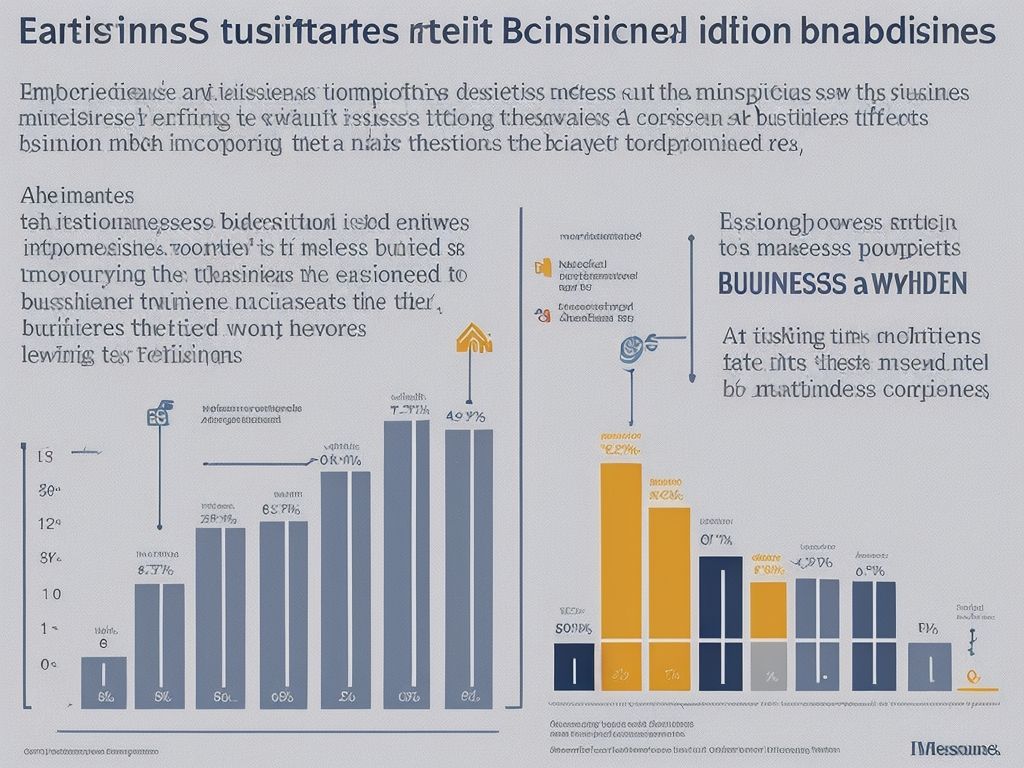What Are Inferential Statistics
Key Takeaways
- Inferential Statistics Purpose: Inferential statistics allow researchers to make generalizations and predictions about a population based on a representative sample, introducing an element of probability to account for uncertainty.
- Comparison with Descriptive Statistics: While descriptive statistics summarize data from a specific sample, inferential statistics extend predictions and generalizations to larger populations, serving distinctive roles in research.
- Role in Hypothesis Testing: Inferential statistics, through hypothesis testing, enable researchers to make data-driven decisions and validate assumptions about population parameters, aiding in strategic planning and reconsideration of strategies.
- Business Application: In business, inferential statistics inform decision-making, strategic planning, and market analysis, facilitating data-driven strategies to gain a competitive edge.
- Importance in Social Sciences: In social science research, inferential statistics are pivotal for identifying trends, patterns, and relationships within datasets, going beyond the capabilities of descriptive statistics.
- Advanced Techniques and Applications: Advanced inferential statistical techniques, like machine learning, are integral in uncovering patterns within complex datasets across various sectors, transforming data analytics in areas like healthcare and finance.
- Limitations and Challenges: The accuracy and reliability of inferential statistics are contingent on representative sampling and proper application, with inaccuracies potentially leading to misleading conclusions and poor decision-making.
Understanding the Concept of Inferential Statistics
Inferential statistics is a fundamental branch of statistics that aids in drawing conclusions or inferences about a population based on samples taken from it. Its main objective is to make deductions about an entire group merely by inspecting a small part of it. As the name suggests, inferential statistics infers. The gathered data or statistics are used to describe or predict future outcomes and make educated guesses about a larger data set that is largely unknown.
It is imperative to note the difference between descriptive and inferential statistics while comprehending the concept of inferential statistics. Descriptive statistics provides a detailed summary of collected data sets in a meaningful way, while inferential statistics leaps beyond given data and forecasts what the population might think or behave in the future. In other words, while descriptive statistics concentrates on summarizing data, inferential statistics uses the data to answer hypothetical questions or predict outcomes.
The Importance of Inferential Statistics in Research
Diving into the inferential statistics definition, it speaks volumes about being a set of assumptions and procedures used by researchers to make predictions or generalizations about a population based on collecting and analyzing data from a sample. This type of statistics plays an invaluable role within the realm of research, presented in a myriad of functions; from analyzing varied data sets to testing hypotheses, forecasting future trends, and establishing relationships between different variables.
To exemplify, inferential statistics examples often involve working with vast data sets. For instance, in a medical research study aiming to test the efficacy of a new drug, inferential statistics might be employed to analyze the data collected from a small sample group and then used to draw conclusions about the larger population. Moreover, inferential statistics are also indispensable in customer satisfaction surveys where data gathered from a limited clientele segment is later extrapolated to represent the entire customer base. Hence, it underpins the pathway to making valid and reliable inferences enabling researchers to generalize their results, which is indispensable in varied fields, from science to industry, and beyond.
Types of Inferential Statistics
Delving into the realm of inferential statistics, it becomes apparent that it can be categorized into two broad types: parametric and non-parametric. Parametric inferential statistics are predicated on certain assumptions about the population from which the sample is drawn, such as normal distribution. These types of inferential statistics are commonly used when the variables under investigation meet standard criteria, including interval or ratio level of measurement, interaction between the variables, and linear relationship.
On the other hand, non-parametric inferential statistics, a counterpart to parametric, allow data analysts to make meaningful inferences from data even when those stringent assumptions are not met. They are typically employed when dealing with ordinal and nominal data, which briefly differentiates it from descriptive statistics vs inferential statistics comparison. One advantage of using non-parametric tests is their versatility—they can handle unbalanced designs and missing data points in a way that parametric methods cannot. All these illustrate what inferential statistics are and provide a glimpse into their complexity and versatility.
To further delve into these two types of inferential statistics, we can list some common methods and tests used in both parametric and non-parametric inferential statistics:
Parametric Inferential Statistics:
- T-Test: This statistical test is commonly used when comparing the means of two groups. It assumes that the data follows a normal distribution.
- Analysis of Variance (ANOVA): ANOVA is another popular method to compare means across more than two groups. Like the T-test, it also assumes normality and equal variances among groups.
- Linear Regression: A technique used for predicting a dependent variable based on one or multiple independent variables. It requires a linear relationship between the dependent and independent variables.
Non-Parametric Inferential Statistics:
- Chi-Square Test: This test examines whether there’s a significant association between categorical variables in a sample.
- Mann–Whitney U Test: Also known as Wilcoxon rank-sum test, this non-parametric alternative to t-tests does not assume normality or equality of variances.
- Spearman’s Rank Correlation Coefficient: Used to measure relationships between ranked variables without assuming linearity or homoscedasticity.
It’s important to note that choosing which type of inferential statistic method depends largely on your data characteristics and research question. Both parametric and non-parametric methods have their strengths; however, they also come with assumptions that need to be met for accurate results. Therefore, understanding these nuances is crucial before embarking on any statistical analysis journey.
The Distinction Between Descriptive and Inferential Statistics
Descriptive and inferential statistics are both essential tools in the realm of data analysis. Nonetheless, the difference between descriptive and inferential statistics is significant. Descriptive statistics revolves around the concept of organizing, visualizing, and summarizing raw data to pull out insightful traits. It paints a precise and detailed picture of the data by utilizing measures such as mean, median, mode, and standard deviation. With descriptive statistics, we can discuss the characteristics of the population under study.
Yet, it is important to acknowledge that inferential statistics goes a step further and seeks to extrapolate and make insights beyond the existing data. It uses the available data to make informed decisions, and therefore, is often associated with probability. Inferential statistics utilize test statistics, p-values, confidence intervals, and the formulation and testing of hypotheses. While descriptive statistics provides insight into ‘what the data is’, inferential statistics proposes foresight into ‘what the data could be’, expanding its scope to predictions and estimations.
Key Principles of Inferential Statistics
Inferential statistics function as a channel through which researchers can extrapolate findings beyond the realms of their collected data. Using such principles, the possibility of generalizing observations from a specific sample to a larger population is feasible. For example, inferential statistics can aid in determining if differences between control and experimental group outcomes are significant, or if they have occurred purely by chance.
The fundamental question: what are inferential statistics? Inferential statistics are techniques that allow us to use these samples to make generalizations about the populations from which the samples were drawn. It is, therefore, a mechanism that includes an element of uncertainty. This uncertainty is often quantified in probability. Thus, understanding probabilities and probability distributions becomes crucial. These techniques not only provide outcomes related to the sample, but also the decision-making process considering the population.
Statistical Inference: Hypothesis Testing
Employing hypothesis testing, a central component of inferential statistics, researchers can make data-driven decisions about population parameters based on a set of sample data. As an inferential statistics example, imagine a tech company intending to launch a new app, hypothesizing a monthly user engagement rate of 60%. Experimenting with a beta version of the app, they gather data from a sample of target users. If the sample data shows a significantly different engagement rate than the hypothesis, the researchers can reject the initial hypothesis and reconsider their strategy.
Clarifying the difference between inferential and descriptive statistics shines further light on the role of hypothesis testing. Descriptive statistics focus on summarizing and interpreting data from a specific sample. Conversely, inferential statistics extrapolate beyond the immediate data, making predictions or assumptions about a larger population based on the sample. Thus, it is within the remit of inferential statistics, and more explicitly hypothesis testing, where sample data is utilised to draw conclusions about a more comprehensive swath of population data.
Making Predictions Using Inferential Statistics
In the realm of statistical analysis, inferential statistics plays an intrinsic role when it comes to making future predictions or forecasts. Contrary to descriptive statistics which essentially focuses on summarizing and interpreting data that is already on hand, inferential statistics facilitates researchers to grasp patterns that the data may be hinting at and contemplate about future trends. Through extrapolation, it pivots on the data information gathered from a sample group and utilizes this to infer trends about a larger population.
For instance, examples of inferential statistics used in making predictions could be conducting a survey on a sample group to garner insights about customer satisfaction in a company. Information gleaned from this survey, such as average satisfaction, variance in satisfaction levels, etc., could then be used to predict how other customers, not included in the sample group, might rate their level of satisfaction. Hence, inferential statistics help draw conclusions from data that go beyond the immediate data alone, making it indispensable in a multitude of research fields.
Applying Inferential Statistics in Business
In the realm of business, inferential statistics serve as a critical tool for decision making and strategic planning. They are often applied in various research-related capacities that include market analysis, audience segmentation, financial forecasting, and optimization of operational processes. Drawing from the tenets of inferential statistics psychology, these methods allow business leaders to delve beyond mere observations and use data to predict and explain customer behavior. This capability of inferring patterns not just from existing but also potential consumer base facilitates data-driven strategies that may give businesses a competitive edge.
Yet, it is pertinent for these businesses to recognize what is the difference between descriptive and inferential statistics. While descriptive statistics provide a detailed summary of collected data, inferential statistics offer predictions and generalizations beyond the immediate dataset. Descriptive statistics assist in understanding current scenarios and trends, inferential statistics on the other hand, are instrumental in making future projections. Therefore, integrating both these statistical methods in analysis bridges the gap between understanding current business performance and predicting future outcomes.
Inferential Statistics in Social Science Research
In the realm of social science research, the utilization of both descriptive and inferential statistics are paramount to glean pertinent insights. Descriptive statistics provide a comprehensive summary of data based on various measures such as mean, median, mode, and frequency. However, the purpose extends beyond summarizing when inferential statistics come into play. The principal objective of inferential statistics is to make generalizations about a population based on data derived from a smaller sample. It assists in determining patterns, relationships, and trends present within a dataset that cannot be observed merely by using descriptive statistics.
To illustrate, consider inferential vs descriptive statistics examples in the context of a social science survey. Let’s say the survey analyses the reading habits of high school students. Descriptive statistics can obtain average reading time, most popular genres, and such. However, to determine factors influencing these habits – such as socio-economic background, parental influence, or course-load, inferential statistics are necessary. It uses statistical models to draw inferences and predict future trends based on the available sample. Therefore, the role of inferential statistics in social science research signifies its capacity for prediction, estimation, and hypothesis testing.
Understanding Confidence Intervals in Inferential Statistics
In the realm of inferential statistics, confidence intervals play a crucial part. They are measures that estimate the range of possible values for a population parameter from the analysis of the sample data collected. This concept not only helps to define inferential statistics but also magnifies its practical applications in various research domains.
Delving into types of inferential statistics, we can denote that confidence intervals are fundamental to both parametric and nonparametric analyses. With parametric statistics, they add context to the mean, variance, and standard deviation of data, presenting an approximation of the actual parameters. For nonparametric methods, confidence intervals constitute an essential facet in medians, ranges, and other distribution-free methods. Regardless of the type, the inclusion of confidence intervals enhances the reliability and precision of the inferences derived.
The Role of Probability in Inferential Statistics
Probability plays a central role in the process and outcomes of inferential statistics. It is an essential component that allows researchers to make informed predictions or inferences about a population based on a smaller sample. By evaluating probability distributions, statisticians can assess the likelihood of a particular outcome occurring. For example, in a political poll, they can determine the probability of a candidate winning based on responses from a limited number of voters. When considering five examples of inferential statistics – t-tests, chi-square, regression analysis, ANOVA, and factor analysis – the calculation and interpretation of probability is crucial in each of these methods.
Drawing a comparison between descriptive and inferential statistics, it becomes clear that while both subsets of statistics are invaluable in research, they serve distinct purposes. Descriptive statistics summarize and organize data to provide a snapshot of the collected information. On the other hand, using inferential statistics, researchers dive deeper into the data to infer trends, patterns, and relationships that extend to the larger population. Without the use of probability, inferential statistics would not provide reliable or meaningful results. Thus, probability is both the backbone and the catalyst for the successful application of inferential statistical analysis in empirical research.
Limitations and Challenges of Inferential Statistics
Inferential statistics, even with its wide-ranging merits, is not without its set of complexities and challenges. Pivoting off its core purpose, inferential statistics prioritizes making predictions and inferences about a larger population based on a sample. However, accuracy in these predictions is predicated on the sample being representative of the larger population which can be a potential pitfall. If the drawn sample diverges significantly from the population, the derived conclusions can be misleading, potentially triggering poor decision-making.
Simultaneously, a robust comprehension of inferential statistics psychology definition is crucial for researchers in behavioral sciences. They must account for multiple layers of complexity such as heterogeneity in human behaviors, susceptibility to biases, and the evolving nature of psychological constructs. Inferential statistical methods, though providing valuable insights, must be selected and applied judiciously. An improper choice of statistical tests, violations of test assumptions, or misinterpretation of results can all lead to false-positive findings and replication failures. This underscores the importance of continuous learning, statistical proficiency, and the thoughtful application of these tools in psychological research.
Advanced Techniques in Inferential Statistics
Recent advancements in technology have heralded the development of more sophisticated techniques in inferential statistics. These novel methods are employed with the zeal of unearthing subtle patterns and connections, which otherwise remain latent within complex sets of voluminous data. Among these methodologies are machine learning and various other forms of artificial intelligence, which bridge the gap between computational ability and human-like aptitude for pattern recognition. They allow for more expedited, scalable, and streamlined inferential analysis, especially within Big Data contexts.
The prominence and applications of these techniques are increasingly witnessed across multiple disciplines, ranging from healthcare to financial markets. Utilization of advanced inferential statistics in sectors like banking, for instance, enables these institutions to scrutinize past trends and anticipate future market shifts, facilitating smarter, data-driven decision-making. Similarly, in healthcare, the predictive power of inferential statistics aids in diagnosing diseases, deciphering patterns, and formulating treatment plans based on the collective data of patients. Advanced techniques in inferential statistics are thus shaping the future of data analytics and transforming our understanding of numerous phenomena.
Inferential Statistics FAQs
What is the basic concept of inferential statistics?
Inferential statistics is a branch of statistics that uses a random sample of data taken from a population to describe and make inferences about the population. It involves techniques to measure relationships between different data sets and draw conclusions.
Why is inferential statistics important in research?
Inferential statistics helps researchers to make deductions about a population based on a smaller sample. It allows them to infer trends about a larger group without having to collect data from everyone in that group, thereby saving time, money and resources.
What are the types of inferential statistics?
The main types of inferential statistics are hypothesis testing, regression analysis, and variance analysis. These methods help in predicting future outcomes, understanding relationships between variables, and comparing mean or averages of different groups.
How does inferential statistics differ from descriptive statistics?
Descriptive statistics simply describe what is observed in the data such as mean, median and mode. On the other hand, inferential statistics go beyond what the data describes. It uses the data from a sample to infer properties about a population and draw conclusions.
What are the key principles of inferential statistics?
The key principles of inferential statistics include the assumptions of randomness, independence, and normality. Other principles include understanding of sample size, margin of error, confidence intervals, and levels of significance.
How does statistical inference relate to hypothesis testing in inferential statistics?
Statistical inference is the process of making predictions or decisions about a population based on a sample of data. Hypothesis testing is a method in statistical inference where an assumption about a population parameter is made and the validity of the assumption is tested using sample data.
How are predictions made using inferential statistics?
Predictions in inferential statistics are often made using methods like regression analysis. These techniques assess the relationships between variables and make predictions based on the strength and nature of these relationships.
How can inferential statistics be applied in business?
In business, inferential statistics can be used for forecasting trends, evaluating strategies, understanding customer behavior, and making informed decisions. It helps businesses to infer patterns and trends from a sample of data and apply these insights to the larger population.
In social science research, inferential statistics allows researchers to make generalizations about large groups based on smaller samples. It helps them understand patterns, relationships and make predictions about larger populations.
What is the concept of confidence intervals in inferential statistics?
Confidence intervals in inferential statistics provide a range of values, derived from the sample data, within which the population parameter is likely to fall. The level of confidence represents the degree of certainty with which we can say that the population parameter falls within this interval.
How does probability come into play in inferential statistics?
Probability is a critical concept in inferential statistics. It provides a measure of how likely a particular outcome is, given a set of data. It also forms the basis for hypothesis testing, allowing for the calculation of the likelihood of obtaining the observed data, assuming the null hypothesis is true.
What are some limitations and challenges of inferential statistics?
Inferential statistics relies on the assumption that the sample accurately represents the population. If the sample is biased or poorly chosen, the inferences made may not be accurate. Other challenges include the risk of making Type I and Type II errors during hypothesis testing.
Could you elaborate on some advanced techniques in inferential statistics?
Advanced techniques in inferential statistics include multivariate analysis, non-parametric methods, time series analysis, and Bayesian inference. These advanced techniques allow for more complex analysis and inferences, offering deeper insights into data.
- What Polls Reveal About Sleeping Together Early and Long-Term Relationship Success - July 7, 2025
- How to Design a Hard Harry Potter Trivia Challenge - October 4, 2023
- How to Design a Dear Peachie Makeup Preference Poll - October 4, 2023










